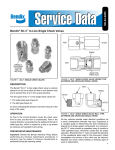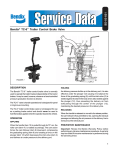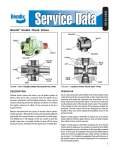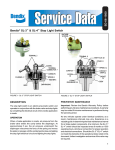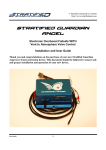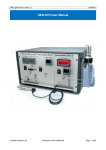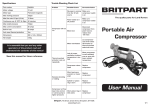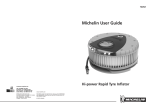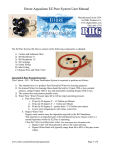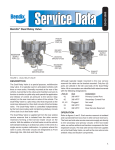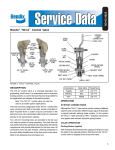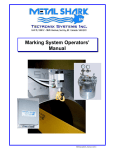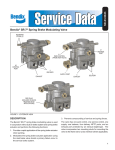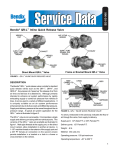Download BENDIX BW2491 User's Manual
Transcript
SD-03-3674 ® Bendix® TCS-9000™ Control Brake Valve HANDLE CAM CAM FOLLOWER GRADUATION SPRING 1/4" PTC EXHAUST EXHAUST PLUNGER 3/8" PTC DELIVERY DELIVERY 3/8" PTC SUPPLY SUPPLY INLET VALVE HORIZONTAL PORTS FIGURE 1 TCS-9000™ trailer control valve configurations FIGURE 2 TCS-9000™ valve sectional DESCRIPTION HOLDING The Bendix® TCS-9000™ control brake valve is normally used to operate the trailer brakes independently of the tractor brakes. It may be used, however, wherever a hand controlled pressure graduation function is desired. As delivery pressure builds up in the delivery port, it is also effective under the plunger causing it to balance the force of the graduation spring until the inlet valve is seated against its seat in the body and is also seated against the plunger, thus preventing the delivery air from exhausting through the center of the plunger, maintaining the desired pressure in the delivery line. The TCS-9000™ valve is handle operated and is designed for dash or panel mounting. It is not designed for use as a parking brake control and should never be used to hold the brakes applied when the operator leaves the vehicle. OPERATION APPLYING When the handle is pulled through its 55° arc, the cam is rotated accordingly. The cam action forces the cam follower downward, compressing the graduation spring and creating a force on the plunger which depresses the inlet valve and delivers air under pressure to the delivery port. RELEASING When the handle is released or moved to its release position, the cam follower is permitted to rise, opening the exhaust passage and allowing the air pressure in the delivery line to exhaust out the exhaust port. 1 PREVENTIVE MAINTENANCE Important: The TCS-9000™ control brake valve is not serviceable. No two vehicles operate under identical conditions, as a result, maintenance intervals may vary. Experience is a valuable guide in determining the best maintenance interval for air brake system components. At a minimum, the TCS-9000™ valve should be inspected every 6 months or 1500 operating hours, whichever comes first, for proper operation. Should it not meet the elements of the operational tests noted in this document, further investigation and replacement of the valve may be required. REMOVING AND INSTALLING Secure the vehicle with spring brakes or blocks. Drain the reservoir which supplies the TCS-9000™ valve. Remove the fasteners which secure the mounting bracket to the panel. Mark and disconnect the connecting air lines. Remove the valve. INSTALLING A typical piping arrangement for the TCS-9000™ valve is shown in Figure 3. Check connecting air lines for integrity and foreign material. Replace the lines if necessary. Re-connect the air lines. Replace fasteners securing bracket to panel. Check operation of valve by charging system and performing the service check as described in this manual. With the valve fully applied, leakage at the exhaust line should not be greater than 175 SCCM (1" bubble in 3 seconds). If the valve does not function as described, or if the leakage is excessive, it is recommended that it be returned to the nearest Bendix authorized distributor for a service replacement. WARNING! PLEASE READ AND FOLLOW THESE INSTRUCTIONS TO AVOID PERSONAL INJURY OR DEATH: When working on or around a vehicle, the following general precautions should be observed at all times. 1. Park the vehicle on a level surface, apply the parking brakes, and always block the wheels. Always wear safety glasses. 2. Stop the engine and remove ignition key when working under or around the vehicle. When working in the engine compartment, the engine should be shut off and the ignition key should be removed. Where circumstances require that the engine be in operation, EXTREME CAUTION should be used to prevent personal injury resulting from contact with moving, rotating, leaking, heated or electrically charged components. SERVICE CHECKS OPERATING When used as a trailer control valve connect an accurate test gauge to the trailer service line hose and leave the trailer emergency or supply hose connected to the trailer or if a trailer is not available, connect the trailer supply hose to an unvented dummy coupling or to a plugged hose fitting. The trailer supply valve should be in the normal position. The exhaust valve closes when the operating lever is moved from 0° to 15° and no pressure is delivered. With 15° to 40° of handle travel the valve delivers proportional intermediate pressures up to 40psi. In the fully applied position, up to 55° of handle travel, the gauge should register full reservoir pressure. Upon release, the gauge should immediately register zero. The location of the atmospheric end of the exhaust line from the valve should be found, probably in the engine compartment. With the TCS-9000™ valve in the release position, no pressure should register on the test gauge and leakage at the end of the exhaust line should not be greater than 100 SCCM (1" bubble in 5 seconds). 2 3. Do not attempt to install, remove, disassemble or assemble a component until you have read and thoroughly understand the recommended procedures. Use only the proper tools and observe all precautions pertaining to use of those tools. 4. If the work is being performed on the vehicle’s air brake system, or any auxiliary pressurized air systems, make certain to drain the air pressure from all reservoirs before beginning ANY work on the vehicle. If the vehicle is equipped with an AD-IS® air dryer system or a dryer reservoir module, be sure to drain the purge reservoir. 5. Following the vehicle manufacturer’s recommended procedures, deactivate the electrical system in a manner that safely removes all electrical power from the vehicle. 6. Never exceed manufacturer’s recommended pressures. 7. Never connect or disconnect a hose or line containing pressure; it may whip. Never remove a component or plug unless you are certain all system pressure has been depleted. MV-3™DASH CONTROL VALVE TP-3™ TRACTOR PROTECTION VALVE S ER EM MODULATOR D D BRAKE VALVE S QR-1™ QUICK RELEASE VALVE S D D TCS-9000™ CONTROL VALVE S D D D S D S RELAY VALVE D S C B S S D QR-1C™ QUICK RELEASE VALVE S D D B en d ix A D -9 P R I MA R Y S E R V ICE SER B e n d ix EM S U P P LY S E CO ND AR Y S E RV I CE FIGURE 3 TYPICAL SYSTEM SCHEMATIC FOR USE A TRAILER CONTROL VALVE 8. Use only genuine Bendix ® replacement parts, components and kits. Replacement hardware, tubing, hose, fittings, etc. must be of equivalent size, type and strength as original equipment and be designed specifically for such applications and systems. 9. Components with stripped threads or damaged parts should be replaced rather than repaired. Do not attempt repairs requiring machining or welding unless specifically stated and approved by the vehicle and component manufacturer. 10. Prior to returning the vehicle to service, make certain all components and systems are restored to their proper operating condition. 11. For vehicles with Antilock Traction Control (ATC), the ATC function must be disabled (ATC indicator lamp should be ON) prior to performing any vehicle maintenance where one or more wheels on a drive axle are lifted off the ground and moving. 3 4 BW2491 © 2005 Bendix Commercial Vehicle Systems LLC. All rights reserved. 6/2005 Printed in U.S.A.




